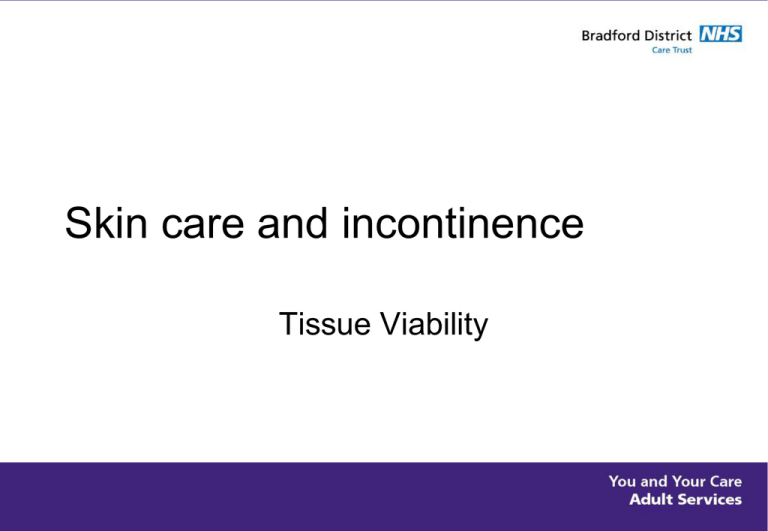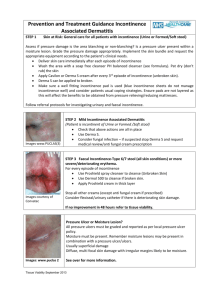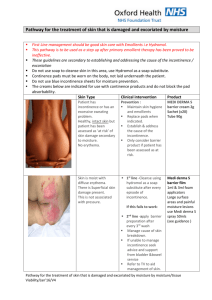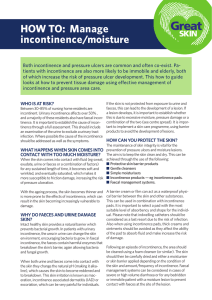
Skin care and incontinence
Tissue Viability
How incontinence damages
skin
• Urinary incontinence changes the normal acid mantle to
alkaline
• Skin becomes vulnerable to friction and shear forces
• A combination of faecal with urinary incontinence renders
skin much more vulnerable than urinary incontinence
alone
• Faecal enzymes cause severe skin irritation that can
quickly result in incontinence dermatitis with skin
breakdown
Incontinence dermatitis
Skin care
• Effective promotion of continence or
management of incontinence is vital.
• Act promptly - Minimise length of time skin in
contact with urine etc.
• Barrier products such as Cavilon™, which is
compatible with many continence aids, may be
applied. This is not a substitute for good hygiene.
• Zinc oxide cream (Sudocrem™) and zinc and
caster oil should generally be avoided.
Cavilon – Durable Barrier
Cream
• 3M Cavilon Durable Barrier
cream-3M™ Cavilon™ Durable
barrier cream protects intact skin
from bodily fluids and helps to
prevent breakdown, whilst
moisturising the skin.
• It is immediately absorbed by the
skin, and therefore will not clog
incontinence pads
• Every 3 washes or daily
Cavilon Film
• Alternatively, if the skin
is already broken and
sore, apply 3M™
Cavilon™ No Sting
Barrier Film, which will
protect the skin against
bodily fluids for up to 72
hours, and promote
skin-healing.
• Moisture lesions, frequently caused
by incontinence, are often wrongly
classified as pressure ulcers
• Moisture must be present (e.g.
shining, wet skin caused by urinary
incontinence or diarrhoea)
• A moisture lesion may occur over a bony
prominence. However, pressure and shear should
be excluded as causes, and moisture should be
present.
• A combination of moisture and friction may cause
moisture lesions in skin folds. A lesion that is
limited to the anal cleft only and has a linear
shape is no pressure ulcer and is likely to be a
moisture lesion. Peri-anal redness / skin irritation
is most likely to be a moisture lesion due to
faeces.
• Diffuse, different superficial spots
are more likely to be moisture
lesions. In a kissing ulcer (copy
lesion) at least one of the wounds is
most likely caused by moisture
(urine, faeces, transpiration or
wound exudate).
Skin care
•
•
•
•
•
•
Regular assessment of at risk areas
Good hygiene
Use of barrier films e.g. Cavilon
Well balanced diet
Adequate fluid intake
Regular repositioning
• Clinicians should develop
assessment skills and management
strategies to manage pressure
ulcers, moisture lesions and also
the combined lesion. In this way,
best use can be made of resources
and patient pain, suffering and loss
of dignity can be avoided.
• Moisture lesions are
superficial (partial
thickness skin loss).
In cases where the
moisture lesion gets
infected, the depth
and extent of the
lesion can be
enlarged/ deepened
extensively.
Why is skin integrity
important?
Thank you for listening












